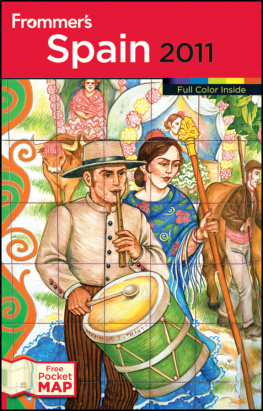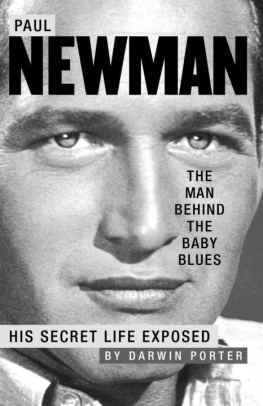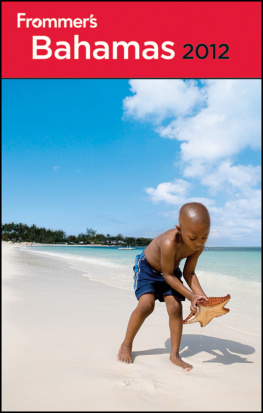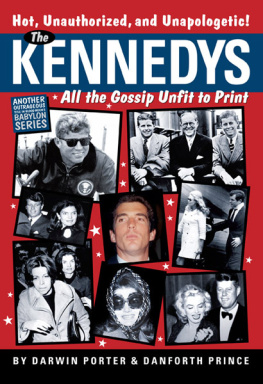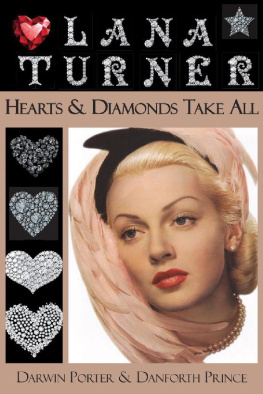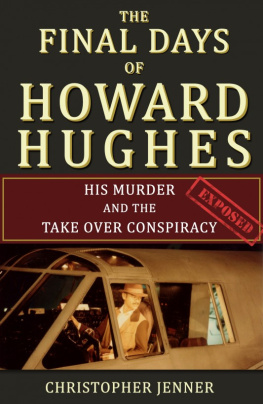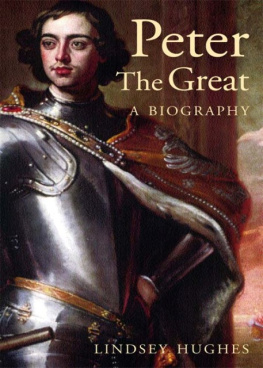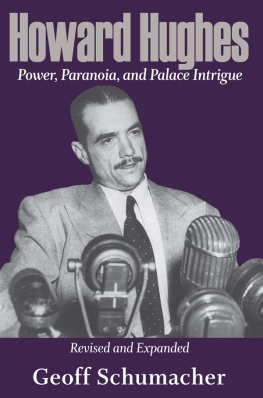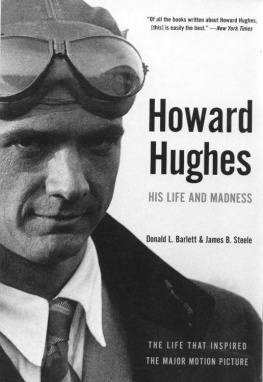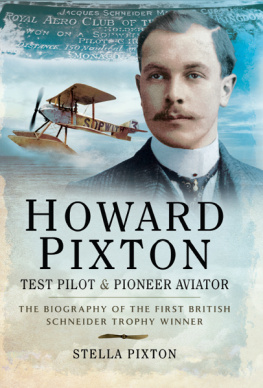ACKNOWLEDGMENTS
This biography is compiled mainly from personal reminiscences of men and women who knew Howard Hughes, Jr. Some loved him at one point or another during their relationship. Some hated him intensely from the very beginning. Ultimately, most of the intimates felt betrayed, usually after they were dumped and Hughes moved on to other conquests.
My first exposure to the complicated legacy of Howard Hughes was during the late 1940s, on the set of Slattery s Hurricane, where my mother was working as an assistant to two of its co-stars, Linda Darnell and Veronica Lake. One day, I overheard them indiscreetly comparing notes about their separate experiences dating Howard Hughes. That night, salaciously, I wrote down everything I heard them say. Hughes sounded fascinating, especially since my mother had just joined the local HUGHES FOR PRESIDENT Club, scores of which were being organized at that time across America. Since it appeared likely that Hughes would become Americas next president, I began a journal. As the decades passed, my notes grew to the point where they filled a large wooden trunk.
Over the years in New York, Hollywood, Mexico, San Francisco, Chicago, London, Miami, Nassau, Virginia, and other places, hundreds of people contributed to my portrait of Hughes. Sometimes, I culled a paragraph or two from someone who knew him only casually. Other revelations were more extensive, as in the case of silent film star Blanche Sweet. But regardless of its source, each bit of information was like a piece of a puzzle, always providing some insightmajor or minorinto this enigmatic figure.
Seemingly everyone who ever came into contact with Hughes, fleetingly or intimately, had at least one anecdote. As was to be expected, some sources were more helpful than others. To each of those who contributed, living or dead, I am profoundly grateful. May the departed rest in peace.
LEST THEY BE FORGOTTEN
Without the pioneering research of Richard Bennettand Rebecca Stroud, I could never have written so extensively and intimately about Hughess early days and his school years. Richard and Rebecca never completed a draft of the book they planned, Young Hughes, but they did manage to compile a pithy collection of research. Reared in Houston, and familiar with that citys legend and lore, they knew Hughess mother, Allene Gano Hughes; his aunt, Annette Gano Lummis; Dudley Sharp, Hughess boyhood friend; and Dudleys mother, Estelle Sharp. They were familiar with young Hughess private schools and summer camps. And as dyed-in-the-wool Houstonians, they knew Ella Rice Hughes and her entourage, gathering the most intimate details I have ever read about Hughess disastrous first marriage. Through Ella, they met James Overton Winston, her early beau, her final husband, and her only true love.
They had originally intended to publish their book in 1938, capitalizing on Hughess newfound cult status as an American aviation hero. But for reasons never sufficiently explained, but which might have derived from potential reprisals from Hughes himself, they abandoned their project prior to the completion of a first draft, leaving their research notes under the stewardship of New York literary agent Bertha Klausner. In the 1960s, envisioning a refo-cused and updated biography of Howard Hughes, Ms. Klausner obtained permission for me to draw upon the research material left behind by Richard and Rebecca.
Another major source of information about Hughes was extracted from Johnny Meyer, Hughess publicist and pimp. No one knew more about Hughess sexual dalliances than Meyer.
I was introduced to Johnny Meyer by the late New York literary agent Jay Garon, who is best remembered for having launched the career of the best-selling novelist John Grisham. In the mid-1970s, Garon negotiated long and hard with Meyer for the production of a personalized memoir about his involvement with the mysterious Mr. Hughes. In exchange for his revelations, Meyer expected a very large advance. Before agreeing to such an advance, Garon insisted that Meyer be vetted as a means of seeing what he had to reveal. I was hired to attend the vetting sessions, taking notes, confirming, and crosschecking his statements with what I already knew about the grimy underbelly of Hollywood. Despite my enthusiastic role as note taker and scribe, Garon did not offer me the job of crafting Meyers memoirs. Instead, he planned to entrust its ghost-writing to James Kirkwood, a well-established novelist and playwright who eventually won a Pulitzer Prize for his contributions to the Broadway musical, A Chorus Line.
When Garon had extracted enough information from Meyer for the compilation of a book proposal, he began tough negotiations with publishers for a stiff advance on what he hoped would become an explosive bestseller. But suddenly, perhaps under threat of reprisals, Meyer abruptly withdrew from the project. The deal was abandoned. Later, Meyer mysteriously died. Perhaps he knew too much.
My enduring thanks go to Stanley Mills Haggartfor the reams of information he gathered, sometimes compulsively, during his many years as a writer, actor, and artist in early Hollywood. He was an inside operator, a man-about-town during an era when a handsome, charming, and debonair newcomer could meet virtually anyone, long before high-security clearances and meddling publicists made casual access to movie stars virtually impossible. Because of his huge contribution to my understanding of Howard Hughes and his entourage, he almost deserves credit for co-authorship of this biography.
Stanley and I formed a 20-year writing partnership that produced more than 50 titles, many of which were renewed at annual intervals, and published by houses that included Simon & Schuster and Arbor House. With an attention to chronology and detail that evoked the style of Marcel Proust, Stanley almost obsessively dictated his memoirs about love, sex, ambition, filmmaking, and scandal in early Hollywood. For years prior to his death in 1980, he worked on drafts of those memoirs. Although theyve never been published, Ive drawn upon them extensively.
Stanley Haggart both lived with and worked for Cary Grantand Randolph Scottduring a period of their affair when Hughes was a frequent visitor to their home. Stanleys insights into the dynamics of this strange trio are deeply appreciated.
The information that Stanley gathered from Noah Dietrichwas invaluable. Stanley first met Dietrich when he worked at Hughess headquarters at 7000 Romaine Street in the 1940s, a job secured for him by his very close friend at the time, Randolph Scott. Dietrich compiled, through a ghost-writer, a slim and uncontroversial volume of his own memoirs, Howard: the Amazing Mr. Hughes, long after hed been ousted from his lofty role as majordomo of the Hughes empire. Published in 1972, four years before Hughess death, its as noteworthy for what it doesnt reveal as it is for what it does. Dietrichs discretion was probably motivated by fear of a libel suit from Hughes. In years gone by, the head honcho of the Hughes empire had purchased many a Hughes biography only to supress it. Dietrich himself feared the same fate for his memoirs.
I also drew extensively upon the journals of Stanleys indomitable and news-conscious mother, Maria Jane Haggart, who migrated to Hollywood early in the 20 th century, when its population numbered only four thousand people. Mrs. Haggart, with her young son, lived next door to the fabled Hollywood journalist and columnist, Adela Rogers St. Johns, who knew a lot about everyone and everything in town. (Detractors claimed that she knew every time that a rat crossed Hollywood Boulevard.) As the decades passed, and as her friendship with Mrs. Haggart deepened, Ms. St. Johns became particularly skilled at figuring out which star had murdered which victim.


